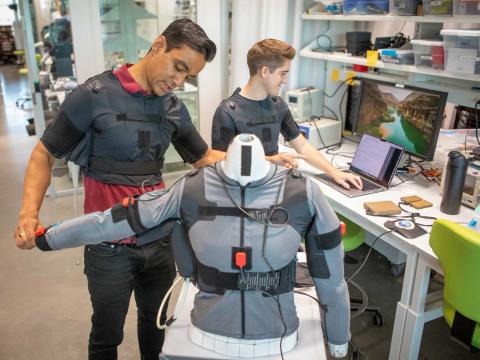The Key to Distributed Logistics Is AI and 3D Printing
Two technologies are key for the future of distributed logistics: predictive artificial intelligence (AI) and additive manufacturing.
“From a predictive logistics standpoint, it's obviously an area that we've been investing into heavily on the naval aviation side,” said Roy Harris, director of sustainment at the U.S. Navy’s Naval Air Systems Command.
“All you can do to help us on the analytical tool set side to get more predictive, it helps with prepositioning,” Harris added, addressing an audience of businessmen and academics at AFCEA NOVA’s Naval IT Day on Monday in Chantilly, Virginia.
The panel “Contested Logistics” focused on the Indo-Pacific and the challenges to supply distributed forces in that area of responsibility. Part of the planning entails stocking supplies in advance as close as possible to where soldiers would be expected to be employed in case of a crisis.
Still, many forces' needs should be addressed at the highest possible speed, the panelists said. According to the group, this means sourcing locally.
“We're knocking on doors in the Philippines and in Australia and other locations where we know advanced manufacturing capability exists, particularly in metal,” said Col. Aaron Angell, director, Logistics Combat Element Division, U.S. Marine Corps.
Angell spoke about additive manufacturing, a set of techniques to produce industrial supplies, which includes 3D printing. This process of creating objects layer by layer using digital designs, typically involving materials like plastic, metal or composites to build parts, allows the Marines to resupply with no need to ship critical components from the United States.
Orchestrating a distributed supply network means that information should flow across stakeholders, where decisions should be made adequately, prioritizing lead times and suppliers.
Therefore, real time communications among all participants are key.
“We aren't going to be able to move everything in the logistics realm to a classified network,” Angell told the audience.

From a predictive logistics standpoint, it's obviously an area that we've been investing into.
A secure nonclassified architecture, where all partners share their stocks, their ability to efficiently procure and their power to produce components with advanced methods, should be comparable to commercially available e-commerce solutions, according to Angell.
“We actually need those commercial partners to talk in somewhat of an encrypted way, too,” Angell said.
If decentralization is well-applied, it will lead to resilient supply networks capable of providing alternatives under stress.
The technologies necessary to deploy these kind of logistics draw heavily from industry, according to the speakers. Thus, they called on those present to bring their solutions to the services and adapt them for military use.
Nirali Chawla moderated the panel.
The Naval IT Day is a yearly event organized by an AFCEA chapter, associated with AFCEA International, SIGNAL Media’s parent.






Comments